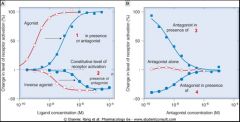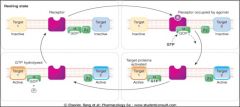![]()
![]()
![]()
Use LEFT and RIGHT arrow keys to navigate between flashcards;
Use UP and DOWN arrow keys to flip the card;
H to show hint;
A reads text to speech;
43 Cards in this Set
- Front
- Back
|
potency?
|
Affinity only
|
|
|
Efficacy?
|
Maximal effect
|
|
|
Drugs modify receptor activity by? (3 mechanisms?
|
activating the receptor, or by changing the characteristics of the activated state of the receptor.
|
|
|
Using labeled receptor studies can yield wht kinds of info?
|
saturable binding implies a specific interaction with a discrete binding site
tissue distribution of receptor may provide clue about its identity and the mechanism of drug action |
|
|
agonist
|
favors active site of receptor
|
|
|
partial agonist?
|
Partial agonists favor the active state, but not as much as a full agonist
|
|
|
Inverse agonist?
|
Binds inactive state of receptor
|
|
|
antagonist?
|
Do not have a preference between active and inactive state of receptor. Simply block agonist binding.
|
|
|
Two state model?
|
R and R* equilibrum changed by binding of one or the other
|
|
|
Induced fit?
|
Drug binding alters receptor shape, stabilizing the active state of the receptor.
|
|
|
Define Chemical antagonism?
|
chelation of drug lowers absorption or effective concentration in bloodstream (dimercaprol vs. Hg2+)
|
|
|
Pharmacokinetic Antagonism
|
one drug activates metabolism and/or excretion of another drug, or interferes with absorption
|
|
|
Receptor competition?
|
drugs with different potencies or efficacies compete for the same receptor
|
|
|
Physiological antagonism?
|
drugs eliciting opposite responses via different pathways/mechanisms
|
|
|
Non-competitive antagonist?
|
affects a step of receptor activation by an agonist other than binding
|
|
|
What is the Schild equation and what is it used for?
|

Ratios of EC50s (without antag) to EC50 (with antag) as a function of antagonist concentration and dissociation constant of the antagonist.
|
|
|
Irreversible Competitive antagonism:
1) change in Km? 2) Change in Vmax |
1) same
2) decrease Acts as functional enzyme loss |
|
|
in what case a partial agonist act like an antagonist?
|
Many GCPRs have significant basal activity, and apparent "antagonists" may actually function as inverse agonists
|
|

fill in 1,2,3,4
|
1) agonist
2) inverse agonist 3) agonist 4) inverse agonist |
|
|
Why spare receptors?
|
-at any point in time a given percentage of receptors may be occupied, but over time, all will be activated and may have long lasting effects. Thus having extra ones allows this buildup of long lasting effects.
|
|
|
Drugs cause two types of responses. Name them
|
Rapid physiological responses
Delayed responses mediated by altered gene expression |
|
|
Mechanism of Desensitization?
B-adrenoreceptors? |
receptor loss/downregultion
|
|
|
Mechanism of Desensitization?
Coumadin, Barbiturates |
enhanced drug metabolism
|
|
|
Mechanism of Desensitization?
Amphetamine |
depletion of a response mediator
|
|
|
Mechanism of Desensitization?
MDR |
increased drug efflux
|
|
|
Mechanism of Desensitization?
histamin receptors |
physiological adaptation
|
|
|
Two phases of desensitization at the NMJ. Describe them.
1)fast 2) slow |
1) change in the functional state of the receptor
2) Decrease in receptor number |
|
|
What kind of drug receptor is being described?
16-20 membrane-spanning segments surrounding a central ion channel |
ligand gated ion channel
|
|
|
What kind of drug receptor is being described?
Growth factor receptors |
Kinase-linked receptors
|
|
|
What kind of drug receptor is being described?
Directly controlgene transcription |
Nuclear Receptors
|
|
|
Describe the activation of a GPCR
|

|
|
|
What is bidirectional control of an enzyme?
|
may be regulated by both excitatory and inhibitory GPCRs
|
|
|
PIP2 cleavage by _____ yields
1) PLC 2)PLA2 |
1)IP3 and DAG
2) arachidonic acid |
|
|
GPCR responses can differ by these mechanism
|
pair to different G-proteins
different agonist can cause different acitve states different downstream effectors Receptor Activity Modifying Proteins (RAMPs) |
|
|
In what case can a GPCR bypass the g-protein?
|
ion channel activation
|
|
|
The nicotinic Ach receptor is what kind of receptor?
|
Ligand gated ion channel (ionotropic)
|
|
|
The Muscarinic Ach receptor is what kind of receptor?
|
GPCR (metabotropic)
|
|
|
Toll-like receptors, insulin receptors, growth factor receptors are all examples of what kind of receptor.
|
RTK
Cytokine receptors too but they are not enzymatically active (need a kinase like JAK) |
|
|
These receptors are involved in many chronic disease states (diabetes, cancer, CVD, obesity.
Many are lipid sensors. |
Nuclear receptors
|
|
|
Zinc fingers are founs in what kind of receptor
|
Nuclear
|
|
|
Class-1 nuclear receptos
1) dimerization? 2) ligands? |
1) homodimer
2) Endocrine ligands |
|
|
Class 2 nuclear receptor
1) ligands 2) dimerization |
1) lipids
2) RXR heterodimers |
|
|
Class 3 nuclear receptor
1) ligands 2) dimerization 3) 2 examples |
Hybrid calss
1) endocrin 2) RXR hetero 3) Vit D., T3 |

